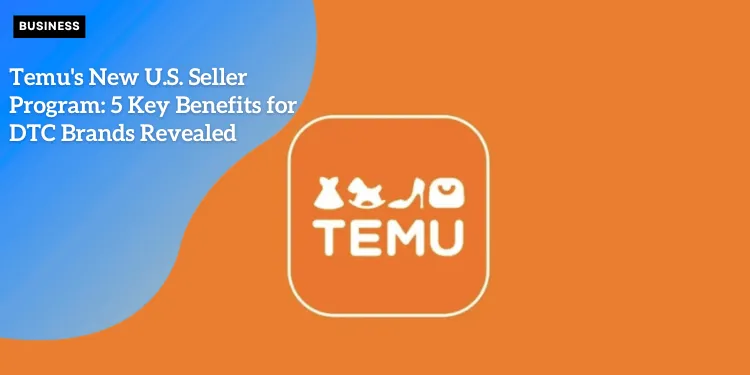Temu’s New U.S. Seller Program: 5 Key Benefits for DTC Brands Revealed

Anúncios
Overview of Temu’s Rapid Growth and Dominance in App Stores
Temu has captured the ecommerce world’s attention with its unprecedented growth, rapidly becoming a major player in the global marketplace.
Launched in 2023, Temu quickly gained traction and, by 2024, it had become the most downloaded free application on Apple’s iOS and Android app stores.
This impressive momentum has solidified Temu’s position as a leading online platform, drawing millions of users seeking discounted products.
Launch of U.S. Seller Program in February 2024
Temu’s success in capturing the attention of a discount-oriented demographic has paved the way for the launch of its U.S. Seller Program in February 2024.
Anúncios
This initiative opens new doors for American direct-to-consumer (DTC) brands, offering access to an extensive and active customer base.
With an estimated 185 million monthly shoppers, both domestically and internationally, the program represents a significant opportunity for U.S. merchants to tap into a rapidly expanding market.
 Temu
Temu
Temu’s Consignment Model and Warehouse Fulfillment System
One of the unique elements of Temu’s operational model is its consignment-based system.
Anúncios
In this model, Chinese and East Asian manufacturers stock Temu’s warehouses with their products.
When a customer makes a purchase, the item is shipped directly from the Temu facility.
This system not only streamlines inventory management but also ensures fast and cost-effective delivery through strategic air freight solutions.
The U.S. Seller Program allows American brands to leverage this robust infrastructure. Sellers can list products on Temu and optionally use its warehouse and fulfillment services.
This consignment model offers flexibility and minimizes upfront risks, making it an attractive proposition for brands looking to extend their reach without the logistical headaches typically associated with international shipping.
By creating a seamless and efficient environment, Temu ensures that sellers can focus on scaling their business and building customer relationships, laying the groundwork for exceptional growth potential and establishing a strong market presence.
Program Costs and Structure
Temu’s U.S. Seller Program has created a buzz due to its simple and accessible cost structure.
Small sellers can enter the program for free, a significant advantage in an often competitive and costly marketplace landscape.
For established businesses, subscription fees range from 2% to 5% of the selling price.
This flexible cost structure aims to accommodate different levels of business operations, making it a viable option for various companies looking to expand their market reach.
Payment Processing Fees
| Fee Type | Details |
|---|---|
| Processing Fee | 2.9% of the transaction amount |
| Transaction Fee | $0.30 per transaction |
| Comparison | Comparable to industry standards for e-commerce platforms |
| Considerations for Sellers | Sellers should account for fees to maintain healthy profit margins. |
Shipping Responsibilities and Market Comparison
Shipping costs are another essential consideration for sellers on Temu.
Unlike some marketplaces that offer subsidized shipping rates, sellers on Temu are responsible for covering the full shipping expenses.
This responsibility underscores the importance of budget planning and efficient shipping strategies to optimize costs.
To put this into perspective, sellers should compare these responsibilities and fees with those of other marketplaces like Amazon or eBay.
While Temu offers direct access to a vast customer base, understanding the full scope of costs involved can help businesses make informed decisions and tailor their strategies effectively.
As sellers begin to navigate Temu’s platform, it’s crucial to keep these factors in mind to leverage the opportunities available while remaining mindful of costs.
Brand Building Opportunities
Direct Engagement with Temu’s Massive Customer Base
Temu’s U.S. Seller Program offers direct-to-consumer (DTC) brands a unique opportunity to engage with its extensive customer base.
With 185 million monthly shoppers, the platform provides an excellent avenue for American brands to introduce their products to a broader audience.
This level of exposure is invaluable for building brand recognition and establishing a direct relationship with customers.
Strategies for Relationship Building Through Packaging and Product Presentation
One of the most effective ways to build a lasting relationship with customers on Temu is through thoughtful packaging and product presentation.
Brands can include personalized touches such as a physical product catalog, a coupon for future purchases, or a note sharing the brand’s story inside the package.
These small gestures can make a significant impact, fostering a personal connection with the buyers and encouraging repeat purchases.
Warranty Registration as a Customer Data Collection Opportunity
Products that require warranty registration present another valuable opportunity for DTC brands.
By prompting customers to register their warranty, brands can collect essential customer data, including email addresses and phone numbers.
This information can be used to nurture customer relationships further, send targeted marketing messages, and gather feedback to improve products and services.
Thus, Temu’s U.S. Seller Program not only offers a gateway to a vast customer base but also provides multiple avenues for brands to engage with and build lasting relationships with their customers.
Through strategic packaging, thoughtful presentation, and leveraging warranty registrations, DTC brands can enhance their brand presence and customer loyalty on the platform.
Next, we’ll explore how sellers can benefit from Temu’s revenue and marketing opportunities.
Revenue and Marketing Benefits
Access to Temu’s Large Discount-Oriented Customer Base
When it comes to driving revenue, Temu presents a unique opportunity for direct-to-consumer (DTC) brands.
Temu’s vast user base, characterized by its discount-focused shoppers, offers a ready-made audience for brands looking to expand their reach.
DTC brands can tap into this massive pool of potential customers to drive sales and increase visibility.
Despite their price sensitivity, Temu shoppers provide an excellent platform to test and validate demand for products.
Participation in Platform-Wide Promotions and Flash Sales
One standout feature of selling on Temu is the ability to participate in platform-wide promotions and flash sales.
These events are designed to draw a significant amount of traffic, offering DTC brands a chance to gain exposure and engage with thousands of potential buyers in a short period.
Through these promotions, brands can drive up their sales volume and build momentum.
Additionally, the promotions enhance the likelihood of repeat purchases, turning one-time buyers into regular customers.
Product Testing Opportunities with No Listing Fees
Temu’s U.S. Seller Program offers a tremendous advantage for new product development by eliminating listing fees.
This means DTC brands can introduce new products and test their market viability without upfront costs.
Brands can leverage the platform to experiment with prototypes or limited-edition items, gathering valuable consumer feedback in the process.
By analyzing how these products perform on Temu, brands can iterate and optimize their offerings for broader market launches.
Looking ahead, the benefits of utilizing Temu’s platform are set to compound, making it a compelling choice for DTC brands aiming to grow both locally and internationally.
With access to a massive user base, promotional tools, and no listing fees, Temu clearly presents significant revenue and marketing opportunities for savvy sellers.
International Expansion Potential
Temu’s new U.S. Seller Program provides exciting opportunities for direct-to-consumer (DTC) brands to venture into international markets.
Access to Chinese Market through Hong Kong Inventory Storage
One of the most compelling aspects of Temu’s program is the opportunity for U.S. DTC brands to tap into the Chinese market.
By storing inventory in Hong Kong or other strategic locations, brands can streamline their distribution process.
This setup allows for faster delivery times and reduced shipping costs to customers in China, making American products more attractive for Chinese consumers.
Reversing the Traditional East-to-West Retail Flow
Traditionally, Western markets have been targets for Chinese-manufactured goods.
However, Temu offers a chance to reverse this trend by providing American brands with access to a vast, untapped customer base in China.
By doing so, U.S. sellers can bring unique products and innovation to Chinese consumers, creating a robust two-way global market flow.
Leveraging Temu’s International Shipping Infrastructure
Temu’s well-established international shipping infrastructure facilitates this cross-border commerce.
With efficient warehouse fulfillment systems and smart air freight strategies, Temu helps reduce logistical challenges and shipping expenses.
This infrastructure ensures that products reach international customers promptly and in excellent condition, enhancing customer satisfaction and fostering global brand loyalty.
By leveraging these international expansion opportunities, DTC brands can significantly broaden their market horizons and tap into new streams of revenue.
This strategic approach promises growth potential, provided brands are prepared to optimize their listings and pricing to match market demands.
Engaging with Temu’s international customer network can be a game-changer for brands looking to boost their global footprint.
Multi-Marketplace Strategy Integration
Diversifying Your Sales Channels
When you’re selling products online, it’s smart to tap into multiple marketplaces.
Incorporating Temu into a broader sales strategy alongside platforms like Amazon, Walmart, and others can provide unique advantages.
Each platform comes with its own set of benefits and tapping into them can maximize your reach and revenue potential.
Establishing Marketplace-Specific Goals
To start, setting clear, marketplace-specific goals is crucial.
These goals could include revenue targets, customer acquisition numbers, or engagement metrics.
Each platform has a distinct audience and understanding what you want to achieve with each can help tailor your approach.
For instance, your objective on Amazon might be to drive high-volume sales, while on Temu, the goal might be to penetrate the discount-oriented market.
Identifying and Understanding Target Audiences
Each marketplace attracts different types of shoppers.
For example, Temu’s customer base leans toward discount-seekers, while Amazon customers might prioritize a wider selection of brands and quality assurance.
Utilize analytics to discern customer demographics and buying behaviors on a per-marketplace basis.
By understanding who your customers are and what they want, you can tailor your product listings effectively.
Aligning Products With Each Marketplace
Aligning your products with the appropriate marketplaces can significantly impact your success.
Consider offering your premium products on platforms where quality is valued more, like Amazon, and your budget-friendly offerings on Temu.
Products that didn’t perform as well or returned items can be listed on eBay, leveraging your inventory in the most efficient way possible.
Optimizing Product Listings and Pricing
Optimizing product listings is key across all platforms, but each marketplace has its own best practices.
High-quality images, keyword-rich descriptions, and competitive pricing are universal strategies.
However, fine-tuning these elements to fit the specific conventions and rules of each marketplace can enhance visibility and drive sales.
For example, Temu might require more emphasis on discounts and compelling visuals that grab attention quickly.
Taking a strategic, multi-marketplace approach helps ensure that you’re reaching different segments of the market efficiently.
By setting clear goals, understanding target audiences, aligning your products, and optimizing listings, you can make the most out of each platform and maximize your overall success.
